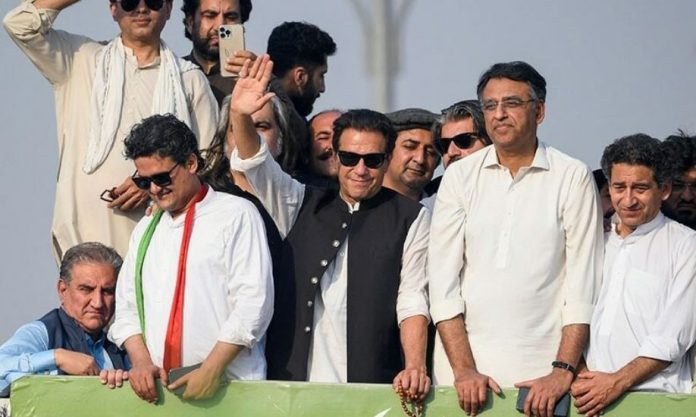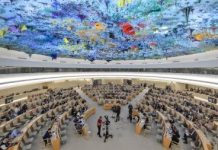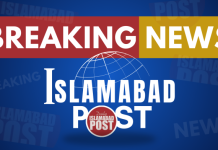Islamabad Inspector General of Police Dr Akbar Nasir Khan on Friday submitted a report to the Supreme Court, detailing the events leading to PTI workers’ arrival at D-Chowk during the party’s ‘Azadi March’ which ended on May 26.
In the report, the police chief said the crowd was “organised to enter D-Chowk under the PTI leadership who had reached Express Chowk with the intent to proceed further toward D-Chowk as per the directions of the party’s highest command”.
On June 2, a five-member bench of the apex court, headed by Chief Justice of Pakistan Umar Ata Bandial, had directed the capital city administration and spy agencies to submit reports explaining at what time Imran Khan had asked his party workers to reach D-Chowk and whether the crowds entering the Red Zone were ‘organised and supervised’ or their act was random.
PTI’s Azadi March on May 25 was preceded by the authorities invoking Section 144 — a measure used to curb gatherings. Shipping containers were put in place on major thoroughfares to block their path.
Undeterred by the moves, the marchers tried to force through the containers to make their way to Islamabad amid intense shelling and baton-charge by the police. PTI supporters were also arrested in cities across Punjab.
The PTI’s march towards Islamabad’s D-Chowk and the shelling of teargas by police took place despite the Supreme Court directives for the former to hold its protest in Islamabad’s H-9 area and orders for the government to not make arrests or use force in connection with the march.
However, Imran had chosen to turn back from the 9th Avenue after giving a six-day deadline to the government for announcing elections and dissolving assemblies and warned that he would return to the capital with the “entire nation” otherwise.
In the report submitted in the apex court today, the Islamabad IG submitted the replies to seven questions put forward by the bench.
What time did Imran Khan make the announcement for party workers to reach D Chowk?
The report revealed that on May 25, at 6:50pm, Imran, in a video message near Chach Interchange, Attock, had “acknowledged the Supreme Court’s judgement and called upon public to reach D-Chowk”.
“[He] also added that he will also try to reach D-Chowk in an hour or so. The message was telecast on mainstream media channels at 7:38pm. The announcement was also made at 9:54pm after crossing the Attock bridge,” it stated.
The report also mentioned that the PTI had initially informed the administration that he wanted to gather his party workers at the Srinagar Highway, between the H-9 and G-9 area. But later, “Imran Khan in a video message announced to (sic) reach D-Chowk via Srinagar Highway and urged party workers / supporters to join him”.
When, where and how did the crowd cross the barricade to enter a hitherto closed area?
The Islamabad IG wrote that the police had closed all the roads leading to D-Chowk on May 25, after the court issued orders allowing PTI to stage its protest at Islamabad’s H-9.
“After the decision of the Supreme Court, police, Rangers and FC were directed to show maximum restraint and they stopped any further action so that the protesters can reach the G-9/H-9 area. However, groups of people led by the leaders kept on moving towards D-Chowk on Jinnah Avenue which is a different route than Sri Nagar Highway. Police and LEAs moved back towards Red Zone as per direction of the police command.”
The report claimed that the protesters “had come motivated” to cross the barriers and “confront the police and LEAs as per the directions of their leadership”. They were armed with wooden sticks and pelted stones at LEAs, it said, adding that they were also “using vehicles to run over police officers”, who were “only having batons to push the protesters”.
Heavy machinery, it pointed out, was also used to remove containers and barriers. The protesters also set trees and bushes ablaze and “mounted on containers”.
“At 7:30pm, the protesters pushed away the containers placed near China Chowk at Jinnah Avenue and cleared the way for their vehicles and expected larger rally,” the report said further, continuing that the police had to resort to tear gas and shelling to prevent them from entering Red Zone.
In the meantime, a group of “approximately 2,000 party workers led by Imran Ismail, Saifullah Niazi, Zartaj Gul and others” gathered near the Islamabad Stock Exchange building at Jinnah Avenue, the report said. “They made several attempts to cross the first layer of containers at the edge of the Red Zone and intrude into the Red Zone but they were repelled by the LEAs through use of tear gas shelling.”
However, the report said, the containers were moved by the protesters early morning next day, May 26. “At 8:05am, PTI workers whose total number at the Express Chowk at that time was 1,000-1,500 approximately, pushed down the upper layer of the second stack of containers after Express Chowk and inside Red Zone.” Rangers and police personnel were present in the venue, it said, but “applied full restraint” and did not resort to coercive actions to stop their entry.
Subsequently, the Rangers and police personnel constituted a layered formation to stop protesters from further movement towards Parliament and other sensitive buildings, the police report revealed. The protesters did not march any further, and the police did not resort to tear gas or other coercive measures, it added.
Was the crowd entering the Red Zone organised or supervised or did it randomly move?
The IG said in the report that the crowd was “organised to enter D-Chowk under the PTI leadership who had reached Express Chowk with the intent to proceed further toward D-Chowk as per the directions of the party’s highest command”.
“In their social media posts from 7:54pm on May 25, Fawad Chaudhry, Saifullah Niazi and Zartaj Gul kept on urging workers to reach D-Chowk for welcoming Imran Khan.”
Were there any acts of provocation or breach of assurance by the government?
The report said that there was no provocation or any such thing from the government’s side or law enforcement. “It was announced time and again through social and electronic media to stay away from the Red Zone by the police/LEAs, administration, and the political leadership.”
It added that the police had chalked out a plan for deployment of the force on orders of the top court and the police “provided free access” to the rally near H-9 and G-9 area.
Was any action or treatment meted out by the ICT police against the protesters disproportionate to the actual or perceived wrong committed by the protesters?
The Islamabad police replied that it had taken lawful, necessary and proportionate steps to disperse the crowd marching towards D-Chowk.
“The police only employed defensive, anti-riot measures to maintain law and order, but the protesters were charged and adamant to move to Red Zone. During the stone pelting by protesters and resistance put up by them 23 LEAs personnel were injured in ICT.”
The report added that the police and LEAs were not issued any firearms to avoid any casualties despite credible information “about armed personnel among the protesters”.
How many protesters managed to enter the Red Zone?
The police claimed that initially, 200 to 300 protesters had managed to enter the Red Zone, but later the amount increased to 800.
Which security arrangements if any were relaxed by executive authorities?
No police officers stopped the protesters from moving towards the assigned spot of the rally, the report said. All police officers were told to withdraw to the Red Zone.
At the G-9 and H-9 venues, barricades were also removed, it added.
Whether any security barrier cordons were broken by protesters or breached?
The protesters, the police said, managed to remove containers near China Chowk and Express Chowk. Moreover, none of the protesters reached the H-9 and G-9 venues, it further highlighted, adding that they all marched to D-Chowk.
In its last answer to the court about injuries during the protest, the police said that 21 civilians were taken to the PIMS Hospital for medical treatment and five civilians were taken to the Polyclinic Emergency. On the other hand, 17 “accused persons” were arrested in 19 cases.












